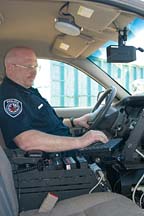Police Car Video a Handy Weapon

Digital video is thought to be more effective than traditional police car video systems, which are based on analog, or videotape technology. Because the police officer must activate analog systems manually, they often fail to capture images of crimes in progress. In contrast, IBM’s in-car digital video system continuously records images and sound onto a 40 or 60 gigabyte hard drive. When an officer turns on a cruiser’s pursuit lights, the previous four minutes of video and audio are saved and recording continues until the officer turns off the system.
Installed in each of the department’s 60 cruisers, the IBM in-car system will collect data via digital video cameras mounted in the cars as well as from audio microphones worn by the police officers. The data will be fed to ruggedized computer hard drives in the vehicles. At the end of an officer’s shift, he or she will remove the hard drive, bring it into police headquarters, and upload any recorded images into a central data repository capable of storing 4.35 terabytes of data – the equivalent of nearly one million full-length novels.
IBM can also equip the system with wireless capability to permit near real-time transmission of video images and sound from the police cruisers to police headquarters by using wireless hotspots. Creating a vital visual link between patrol officers and precinct personnel, wireless transmission can help protect the safety of officers and citizens as well as assist in the coordination of police efforts.
Looking for a reprint of this article?
From high-res PDFs to custom plaques, order your copy today!






